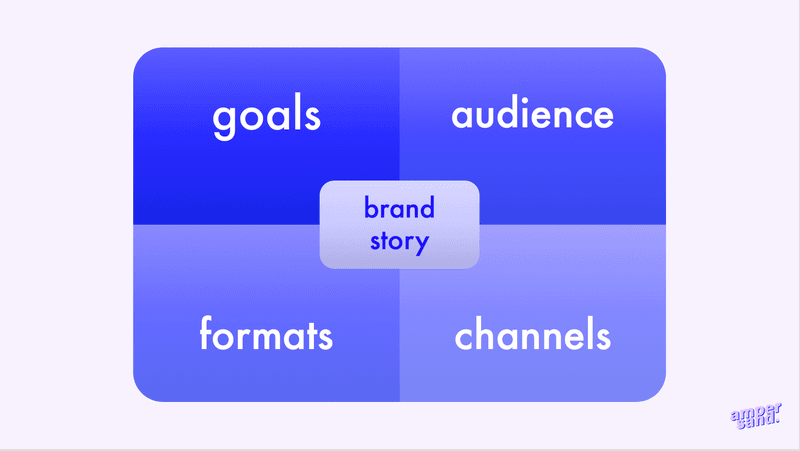Build a Content Strategy in 5 Steps: Stop Wasting Your Time on Content (Unless You’ve Got a Strategy)
Content Marketing Masterclass: Part Two
If you’ve read Part One of this Content Marketing Masterclass, you should be well aware of all the benefits of content marketing for your business.
Excited much? That makes two of us.
However, before you start churning out content for content’s sake, you should seriously consider creating a solid content strategy.
If you skip this step, you risk pouring in a ton of time, energy and resources for very little return. So hold off on writing that killer blogpost for just a second, and discover how to create a content strategy step by step.
You’ll thank me later.
This post is Part Two in a brand spanking new Masterclass Series on Content Marketing. We believe it’s an incredibly important topic – and according to a little survey we did, you do too. Trouble is: there is so much content on content marketing out there (talk about meta) and a lot of the intel is conflicting.
We bring this Masterclass to you in partnership with Anouck Meier, Chief Storytelling Officer at Ampersand. Anouck is a conversion copywriter and a content marketing strategist who has worked with numerous brands, big and small, to help them achieve their business goals through strategic content. Let’s get the story on content straight once and for all in a comprehensive guide. Ready to dive in?
– Jeroen Corthout, Co-Founder Salesflare, an easy-to-use sales CRM for small B2B companies

What is Content Strategy?
“I’m so excited to talk strategy and definitions and business jargon and gobbledygook!”.
– no-one ever
While the very subject apparently makes a lot of very smart people want to sit in a corner and cry it is important to have a common understanding of what a content strategy is.
A strategy defines a specific course of action that will take you from where your business is now to where you want it to be. It’s basically “where to play and how to win.”
A content strategy, specifically, guides you through the creation, publication, distribution and management of useful content. It defines how you’re going to use content to achieve your business goals and to meet your audience’s needs.
Your content needs to have a well-planned purpose and that purpose should be in line with your business objectives. From the tiniest tweet to the epic 10 part Masterclass Blog Series: if it’s not aligning with you company’s greater vision, it’s a waste of time, energy and money.
The 5 key elements to consider in your content strategy are:
- What are you trying to achieve?
- Who are you targeting? Who is your audience?
- What’s your unique brand story?
- What content formats will you be using?
- Which channels will you be using to distribute your content?
These are crucial questions to answer before determining how you will create, publish and distribute content consistently in your content marketing plan.
We’ll dive deeper into each of these questions below when we get into the nitty gritty of how to create your own content strategy.

Why Do I Need a Content Strategy?
If you don’t have a content strategy yet, you’re not alone. In fact, the stats show that content strategy is one of the areas marketers struggle with most (Source: Content Marketing Institute):
- 63% of businesses haven’t got a documented content strategy
- 64% of marketers need help on building a better content strategy
- 60% of marketers find it difficult to produce strategic content consistently
Trouble is: without a strategy, success or failure is just a matter of luck – and you risk all your precious efforts going to waste. 🤯
Creating content without a plan is like hiking in the wilderness without a map or a compass: you may reach the summit and get back to civilization in the end, but chances are you’ll end up wandering around aimlessly, getting frustrated and hungry (and depending on your location, a grizzly bear might have you for lunch). 🐻
It’s no surprise that those companies who do have a strategy are most likely to feel that their content marketing efforts are successful.
When asked which factors B2B marketers attributed to the increased success of their content marketing, 72% referred to strategy development and/or adjustment. (Source: Content Marketing Institute)
It really pays off to document your strategy as well: 62% of the most successful marketers have a documented content strategy. (Source: Content Marketing Institute). According to annual research by MarketingProfs, these marketers:
- are far more likely to consider themselves effective at content marketing
- feel significantly less challenged with every aspect of content marketing
- are able to justify spending a higher percentage of their marketing budget on content marketing

Content Strategy = Content Success
If you approach content marketing strategically, it will help your business plan for reliable and cost-effective sources of website traffic and new, qualified leads to boot. Even one single evergreen piece of content can create that steady amount of organic traffic, and adding a freebie in the mix will help generate leads for you as time goes on.
What’s more, your content will not only help attract leads – it will also help educate your target audience and generate awareness for your brand.
It’s no wonder that learning how to create an effective and scalable content marketing strategy is one of the greatest educational needs of marketers. (Source: Content Marketing Institute).
If you too have been wondering how to create a content strategy for your business, I’m here to help. No more throwing spaghetti against the wall: let’s dive in to learn the specifics of how to create a content strategy.
How to Create a Killer Content Strategy in 5 Steps
This guide will walk you through 5 steps to developing and executing a content marketing plan that’ll help you grow your business without wasting time and money.
Step 1 – Goals: why are you creating the content you’re creating?
Chances are, you want to produce your content to meet one of the following objectives:
- Attracting new high quality leads and eventually paying customers
- Making more sales, increasing your revenue
- Raising awareness about your company and creating a buzz about it
- Gaining influence and authority
- Fostering a community and giving your tribe a reason to tell others about you
Getting crystal clear on the exact goals you’re trying to reach, is crucial. But you also need to have a way of knowing when you have achieved them. That’s where setting key performance indicators (KPIs) for your content marketing strategy comes in.
They’ll include what you plan to achieve in terms of:
- Revenue
- Sales
- Traffic
- SEO
- Email marketing (list growth, open rates, click rates,…)
- Social media metrics
- Marketing expenditure
Take note of your goals and KPIs and plan to monitor your progress towards these goals regularly. There’s nothing that will provide you with a nerdgasm quite like checking off those boxes and seeing the metrics coming out of your hard work.
Step 2 – Audience: who are you targeting with your content?
Seems like a simple enough question, right?
In reality, however, I often see companies missing the mark completely on this one. And believe me: if you fail to properly define your content’s audience and truly understand them, it’s virtually impossible to hit those ambitious content goals you had lined up in step 1.
Avoid the classic rookie trap of trying to target “anyone” or an overly broad defined audience. When it comes to content, one size does not fit all: if you’re trying to speak to everyone at the same time, no-one will truly feel like your content is written for them.
Your content strategy can only be effective if you clearly define your content’s target audience. By knowing your target audience, you can produce more relevant and valuable content that they’ll want to read and convert on.
Try and get clear on the following questions:
- Who exactly do you want to target with your content?
- What are their preferences?
- Where are they hanging out?
- What types of media or which platforms resonate with them?
- What are their problems?
- How can you help them?
Whatever you do, don’t just assume you know the answers!
Customer research is vital for any successful content strategy. Valuable data can be gathered by checking what types of sites your prospects are already visiting, which content they engage with, and which social media platforms they share content on.
One of the most basic forms of customer research is to engage in a dialogue with your prospects or customers. Ask them what they’re looking for, how you can help them solve problems. Conduct a simple survey or have a pop-up on your site asking them. Go and hang out with them in Facebook Groups or have a conversation on Twitter. Monitor what they’re talking about, which questions they’re asking.
Extra tip: keep a file where you gather this data and be sure to copy their exact wording – this will become an invaluable swipe file to inform your copy going forward.
In for something a bit more advanced? Enable Google Demographics and Interests to check the types of sites prospects engage with. Then have a look at Google Analytics for the content they engage with, and review which social platforms are popular for sharing on content pages.
In Google Analytics, click on Behavior>Site Content>Content Drilldown to determine which content is producing the best results.
With all this information, you’re ready to create content that is targeted to your audience, rather than just the content you want to read. In one of the following parts of this Masterclass, we’ll dive much deeper into the subject of generating content ideas.
Finally, don’t forget to revisit your audience parameters regularly by conducting customer research.

Step 3 – Formats: What type(s) of content will you create?
Next up is determining which types of content/formats to create.
There is a plethora of options out there. Here are some of the most popular content formats marketers are creating:
- Blog posts
- Vlogs
- Podcasts
- Ebooks
- Infographics
- Stories
- Social media posts
- Webinars
I strongly advise having a central core of content published on your own website which can then be repurposed and shared on other sites or platforms. Make sure this core content is valuable, actionable and shareable.
A word of warning: when you’re just getting started, it’s easy to get excited and start creating a whole range of different content types.
Whatever you decide to pick, don’t overdo it: if you want to establish authority and become seen as a thought leader you’ll want to put out content consistently.
Especially when your resources are limited, it’s far better to concentrate your efforts on a limited number of formats (even just one) rather than spreading yourself thin. A deserted blog or YouTube channel is not doing anyone any favors.
Before making a final choice ask yourself: what can I keep putting out there over and over and over again?
Step 4 – Channels: where are you going to spread the word?
I hate to break it to you, but if a blog, vlog or podcast is going to be the central hub of your content strategy, your work is not done after hitting the publish button. Gone are the days when people would just come and check whether you had a new blogpost up (and yes, I have witnessed the existence of such an era).
How is your content going to be found, accessed and shared after you’ve published it? Where are you going to promote and distribute all that juicy good stuff?
Your best bet to get eyeballs on your content is to serve it up where your audience is already hanging out. It’s much easier to meet them there, than to try and tempt them to visit a place they don’t usually go to. Focus your efforts on the platforms your audience already uses, or where you already have a successful presence. You can always expand later.
Not sure where to put a stake in the virtual ground? Take another look at those website analytics. In Google Analytics, go to Acquisition>Social>Overview to see the main social media where your content is being shared. Buzzsumo allows you to find similar data through their Content Analysis tool.
Another channel that is simply perfect for distributing your content is email. Subscribers to your email list have already shown interest in your company or products, so sending them relevant content on a regular basis and gently nudging them to go over to your site is a great idea. A brand new relevant blog post is the perfect excuse for sending them over.
Step 5 – Brand Story – Who Are You?
Before you can truly understand your customers, you have to understand yourself. If you don’t want to take my word for it, take content marketing evangelist Joe Pulizzi’s. According to Pulizzi, it’s vital to create a separate and unique identity. To develop an enduring and memorable brand that will set you apart from all the others in the crowded marketplace you’re competing on.
So tell me, do you have a clear answer to these questions?
- What’s unique about you and your company?
- What’s your point of view? Your perspective?
- What does your company stand for?
- How do you sound?
- What makes you different from your closest competitors?
In this day and age it’s incredibly difficult to create a product or service which is really unique in and of itself. Which means your potential customers need to know exactly what makes yours different.
Your audience wants to know who you are and what you stand for. You need to move past what your product or services offer, which is where content comes in. In order to prove why your company is worth buying from, you need to prove why you’re worth listening to first.
Make sure you spend some time getting clear on your mission, your positioning and purpose. Define your most important brand benefits. And finally, map out your brand’s personality, voice and tone. They are the expression and embodiment of your company’s personality, beliefs and values.
Do you have a clear content strategy? Or are you taking the spaghetti-against-the-wall approach? Let us know in the comments!
And don’t forget to check back next week for Part Three of our Content Marketing Masterclass about generating ideas for your content!

We hope you liked this post. If you did, spread the word!
👉 You can follow @salesflare on Twitter, Facebook and LinkedIn.
- Measuring Content Marketing ROI: Show Me The Money - October 10, 2019
- Repurposing Content: 4 Easy Ways to Get More Out of Your Content - October 3, 2019
- The Ten Commandments of Effective Content Distribution - September 26, 2019
